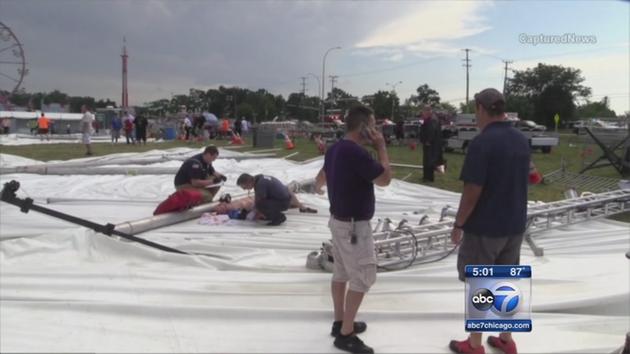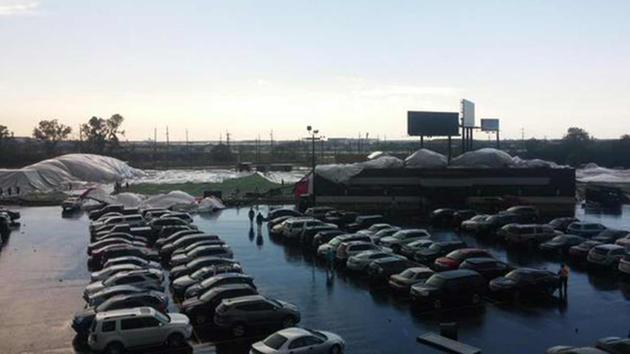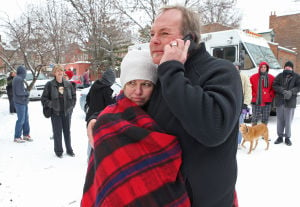July 31, 2015 11:00 pm
By Valerie Schremp Hahn
Kelly Greene and her husband, Bret Schnitker, comfort each other as they watch their business, Star Designs, burn in Soulard on Wednesday afternoon, Feb. 5, 2014. A gas explosion set off the fire in the business at the corner of Shenandoah Avenue and Menard Street. Photo by J.B. Forbes, jforbes@post-dispatch.com
ST. LOUIS, MO
An investment group and a clothing and manufacturing firm has filed a lawsuit against AT&T and two of its contractors, saying the contractors were responsible for striking a natural gas line with led to a gas explosion of the business' building.
The explosion leveled the building at 2222 Menard Street in Soulard on Feb. 5, 2014. The suit was filed by Stars Investment Group, Stars Design Group, and the business owners Bret Schnitker and Kelly Greene. They named subcontractors MasTec and Four Winds Construction in the suit, filed Friday in St. Louis Circuit Court.
Stars Investment Group owns and rents office and living space and Stars Design Group is a clothing design and manufacturing firm.
The construction crew struck a natural gas line and about a dozen people evacuated the area. Thirty seconds after everyone left, explosions rocked and leveled the building, the suit says.
The suit says the Missouri Public Service Commission investigated and found that the subcontractors violated several safety statutes and that the construction crew was unlicensed and should not have been working on the property.
Star's Design Group has talked with insurance companies representing the subcontractors and AT&T and nobody has offered any compensation to rebuild. The spot where the building was is now a vacant piece of land, and the businesses are now based a block away.
“The destruction of SDG’s headquarters shuttered its business for at least two months and otherwise delayed potential sales for much longer,” the suit says.
///--------------///
About a dozen people escape Soulard business seconds before gas explosions
Emergency crews respond to a gas explosion at Stars Design Group on Wednesday, Feb. 5, 2014, at the intersection Shenandoah Avenue and Menard Street. Workers were installing fiber optic cable for the design company, in a three-story building at the corner, when they hit a gas line, according to Jordan Dial, a foreman for the construction company. No one was injured. Photo by Laurie Skrivan, lskrivan@post-dispatch.com
February 05, 2014 11:30 pm • By Joel Currier
ST. LOUIS, MO
About a dozen people narrowly escaped a natural gas explosion Wednesday afternoon at a clothing design firm in the Soulard neighborhood, authorities say.
Firefighters knew of no injuries, although one man at the scene said his back was hurt when he was thrown off his feet by the blast.
“No injuries were reported to us nor did we transport anyone,” St. Louis Fire Capt. Garon Mosby said.
A construction crew was installing fiber optic cable for the Stars Design Group in a three-story building at Shenandoah Avenue and Menard Street in Soulard, when workers hit a gas line after 1 p.m. Wednesday, according to Jordan Dial, a foreman for Four Winds construction company. The company, based in South Dakota, was working for AT&T.
Workers smelled gas and called 911, Dial said. Dial said none of his workers was hurt; he said everyone inside the building got out safely before the explosion. Workers alerted people inside the business of the leak.
Firefighters responded to the business at 2222 Menard Street and tested the gas levels in the air.
“Our meter was going crazy,” Mosby said.
Firefighters then immediately ordered everyone out.
“It was pretty much a life-and-death order,” Mosby said.
Bret Schnitker, 50, who owns the business, said that after the crew struck the gas line, his 11 employees went to a rear building.
“Thirty seconds after leaving, there were two or three major explosions,” Schnitker said.
Katie Sharp, 27, of St. Louis, a merchandiser for the firm, said she was distraught by the explosions.
“When everything happened and the building exploded, I cried,” Sharp said. “We are still in shock. Thank God everybody got out in time. Had it not been for the fire department to come in and tell everyone to get out, things would have ended differently.”
Azem Dullovi, 29, of St. Louis, a maintenance worker for the business, said he had been holding open a metal gate while the construction workers dug outside. He said the explosion threw him several feet, knocking him over and hurting his back.
More than an hour later, he said he was still suffering irritation in his throat, nose and mouth from the fire and smoke.
“I could have been dead,” he said.
The blast set off a fire, which was quickly contained but burning inside the business for several hours as Laclede Gas Co. employees worked to shut off the gas line, Mosby said. Firefighters were able to extinguish the fire shortly after 6 p.m.
Laclede tweeted that crews responded immediately after the explosion and cut gas service to a large area around the intersection. Mosby said electricity also was cut to the 2200 block of Menard Street and rear-facing homes on the adjacent alleys as firefighters and Laclede crews investigated.
Mosby said firefighters had to force their way into some buildings on the block to make sure no one else was inside.
Late Wednesday, some residents were returning home, Laclede reported, but others were still at nearby restaurants and bars, waiting for power.
“We have multiple service techs going door to door now, beginning to relight pilot lights,” said Jenny Gobble, a spokeswoman for Laclede. “That’s our last step to bringing back service for all the families in Soulard.”
Gobble said that 21 buildings — all but the one damaged by the fire — will be turned back on.
Margaret Gillerman of the Post-Dispatch contributed to this report.

















 Babies and young kids can sometimes sleep so peacefully that we forget they are even there. It can also be tempting to leave a baby alone in a car while we quickly run into the store. The problem is that leaving a child alone in a car can lead to serious injury or death from heatstroke. Young children are particularly at risk, as their bodies heat up three to five times faster than an adult’s. These tragedies are completely preventable. Here’s how we can all work together to keep kids safe from heatstroke.
Babies and young kids can sometimes sleep so peacefully that we forget they are even there. It can also be tempting to leave a baby alone in a car while we quickly run into the store. The problem is that leaving a child alone in a car can lead to serious injury or death from heatstroke. Young children are particularly at risk, as their bodies heat up three to five times faster than an adult’s. These tragedies are completely preventable. Here’s how we can all work together to keep kids safe from heatstroke.









